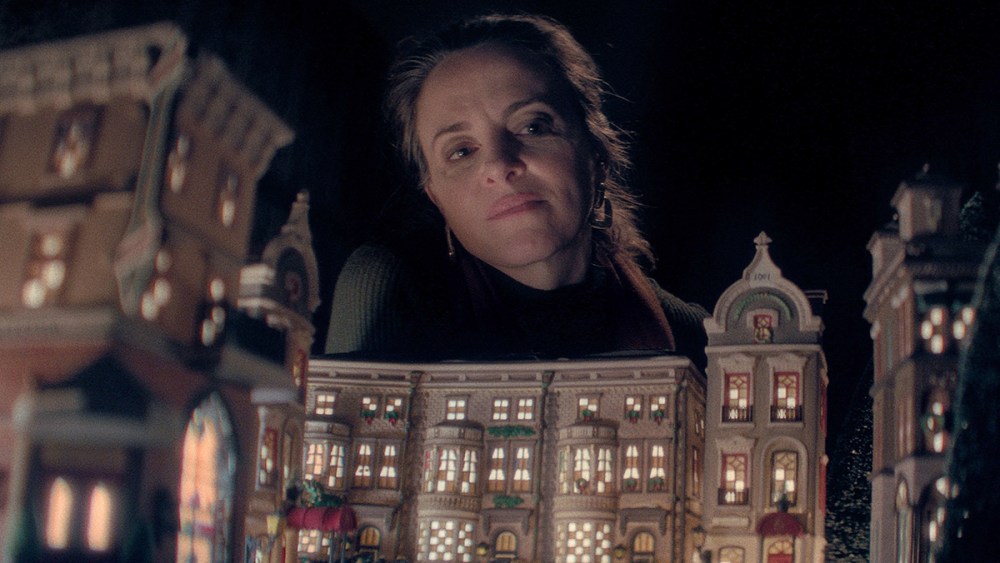‘Christmas Eve in Miller’s Point’ Is an Instant Holiday Classic
Filmmaker Tyler Taormina quickly fell in love with IFC Films’ idea for how to market his merry-and-bright feature. The indie distributor’s trailer for “Christmas Eve in Miller’s Point” plays as a full-on throwback to how holiday season comedies used to be advertised, complete with baby boomer doo-wop, a long list of grinning cast members and a warm narrator promising that, “It’s more than a holiday. It’s a gift for the whole family.” But the nostalgic packaging came with an unforeseen side effect.
“A lot of the people online are like, ‘Oh, I thought it was a horror movie.’ It was a very common reaction that was not at all thought of,” Taormina shares. “Earnest nostalgia is not able to be detected. The irony is expected. It bummed me out.”
No killer is mucking up the holiday in “Miller’s Point,” now playing in theaters after premiering in the Directors’ Fortnight section at Cannes. The Balsano family has plenty on their minds already. Nobody wants to eat the mountain of salami sticks on the appetizer table. The teenagers are itching to sneak out into the night. And the ancestral Long Island home where they’ve gathered each year now seems destined to hit the market, as the Balsano siblings weigh moving their aging mother into an assisted living facility.

The Bolsano family listens to a toast in ‘Christmas Eve in Miller’s Point’
In Taormina’s film, the holidays are a time to feel gratitude for what you have — because one day it won’t be there. Produced by the Omnes Films collective, “Christmas Eve in Miller’s Point” maintains an Altman-like thrill of exploration among its vast ensemble of characters, which flash the full range of goofus to gallant. The curious camera darts around, not just between the Balsano family, but also out into the streets. After dessert is served, the high-schoolers overrun their dead-end town, populated by emotionally stunted, Grinch-ian cops (the conspicuously recognizable Michael Cera and Gregg Turkington) and loitering, smoking do-nothings like Splint (Sawyer Spielberg). There’s less to be merry about outside the hearth, which puts the sacred warmth of the Balsano reunion in perspective — and also exposes the shared mania that propels the family affair. It’s a familiar frenzy that’s come hand-and-hand with Christmas movies, and real Christmas gatherings, for decades.
“I love the Hallmark Christmas movies so much,” Taormina says. “I mean, some of them I can’t stand — when the military is involved. But they really are showing you, in the least censored and most distilled way, a commercial message that life is good. This is everything that is promised, without any cynicism or irony.”
“We watch ‘Home Alone’ and ‘National Lampoon’s Christmas Vacation’ and even ‘All That Heaven Allows,’ and they colonize our minds. We then bring what we learn into our own experiences. It’s similar to how Long Islanders,” Taormina catches himself. “Sorry, how Italian Long Islanders understand themselves through ‘Goodfellas.’ Martin Scorsese and his movies have taught a fourth- and fifth-generation of Italians how to be Italian. It’s also how we celebrate Christmas, in direct conversation with these iconographic things like Coca-Cola and Disney World.”
A self-described lover of “maximalist filmmaking,” Taormina fully commits his feature to the holiday’s kitsch novelties. After all, what’s more maximalist than Christmas? There are big hearty laughs to be found in “Miller’s Point,” but the film never betrays a bittersweet skepticism about the reasons for the season. With its patient, evolving compositions (Taormina cites Hou Hsiao-Hsien as an inspiration), “Miller’s Point” indulges all the Americana dressing, but also looks beyond it to expose a shared insecurity at the center. What compels all of us to reconvene and put on a big show at the end of the calendar year?
“What’s it called when you numb your jaw?” Taormina trails off. Then, “Novocaine! I think of the romance of youth fading into the stark reality of being an adult as a sort of analog to America. Everyone was so excited for the future in that post-World War II era. Now, who’s excited? We’re all really terrified about everything. Horror films aren’t going anywhere.”

Chris Lazzaro in ‘Christmas Eve in Miller’s Point’
IFC Films
The film features a mix of first-time actors and more familiar faces, like Maria Dizzia and Elsie Fisher. How do you sell a project with such a sprawl of characters to professional actors?
Most of the time it would start with sending my first feature, “Ham on Rye.” There are a few name-brand actors in this, but there were even more before we had to move production three months. We lost all of them due to scheduling conflicts — people like Steve Guttenberg and Michael Showalter. Parker Posey and I were on the phone and she said, “I’m doing a play. I can’t do it.” But I remember the way in which I described it to her was that it’s like how we decorate our homes for Christmas, with all these tchotchkes and little ornaments. My writing partner Eric Berger and I realized that these are totally excessive, and yet they’re proof that we want to celebrate life. We made the parallel from that to our memories — a glance an uncle would make, the way a certain light shines. They are just ornaments of our minds.
I imagine you’re drawing from your own family in conceiving many of these characters.
It doesn’t include just my family, but Eric’s and Kevin Anton’s, my editor. It’s definitely busy frames — in a John Ford way.
Matching the spirit of the ensemble effort, I noticed that there are production design credits for a number of real families.
Our production designer Paris Peterson — honestly, he killed himself making this movie — would interface with a ton of people in the community and searched through their houses for items that meant a lot to them. If we brought them to the film, we would include them in the credits. The house is filled with a whole community’s most cherished artifacts of their Christmas celebration.
Could you speak to the curation of the soundtrack? There’s a handful of Christmas songs, but most of it is mid-century bubblegum pop.
I like how you say that there’s some Christmas songs in there, because it’s actually not true. These bands in the ’60s — a lot of these Phil Spector-era groups — went on to make iconic Christmas songs and sounds. The soundtrack was written to Kenneth Anger’s “Scorpio Rising.” It’s an interesting juxtaposition, but it’s just true. There are four or five songs from that in the movie.
Like Peggy March’s “Wind-Up Doll,” which you put over a sequence of the family opening gifts here.
I picture those moments that happen when the family gets together, where you, by this weird osmosis, all make your way into the same space before you have to — before the gifts, before the dinner. Somehow we all floated into the same space for a second. And I just put the song to that moment. It just felt right.
Have you shown the film to family members? How did it go over?
It’s funny. This film is such an exercise of sentimentality. I just don’t think my family is sentimental like that — or existential that way. So when they watch, they’re like, “Oh, that’s great.” Not, “Holy shit. This is our lives. They mattered so much that they wanted to do this whole mountain to honor it.” I don’t think it went that way. It was an interesting gap between the way in which we perceive.
Do you think of yourself as a particularly nostalgic filmmaker?
I don’t have any shame in saying that. Although, of course, in the era of “Stranger Things,” that could be interpreted as something very… uninteresting to me. But what really preoccupies me is aging. Not even the fact that I’m concerned about my skin wrinkling — more so what purity and innocence we lose along the way. This is a coming-of-age film for every single age represented in the film, which is basically the whole lifespan of a human being.

Matilda Fleming, Francesca Scorsese, Leo Hervey and Ava Renne in ‘Christmas Eve in Miller’s Point’
IFC Films
There are mainly the grown-ups and the teenagers, and the film eventually splits the two groups up. But there aren’t really characters in their early adulthood, like you and I.
It’s hard for me to write people of my own age. I really avoid it. Maybe the closest person would be Sawyer Spielberg’s character, Splint: the failure. I hadn’t thought about that. Mmm, what does that mean?
The film largely sticks to the teenage characters through its second half. Could you discuss the impulse behind that decision?
Teenage years are — in my experience, and I think in everybody’s — the most formative switch. It’s the biggest threshold we cross. Which is to say, it’s the most distilled way to look at what crossing a threshold looks like. Everything changes the quickest there. It’s what Joan Fontaine calls the second birthday in “Letter From an Unknown Woman.” Human beings have two birthdays: one where they’re born and one where they come into consciousness.
There are a lot of adolescent cast members in both “Ham on Rye” and “Miller’s Point.” Is there something you find particularly exciting about working with young actors?
For both features — and potentially for “Rise of the Beta Cucks,” a comedy which could be the next film that we make — I actually like casting younger than the teenage characters because I like diminishing them as much as I possibly can. I like making them seem super-infantilized. I go in the other direction, while “Euphoria” presents you with twenty-somethings fucking each other. As does most of the industry.
Is “Rise of the Beta Cucks” a period piece like “Miller’s Point”? Or more contemporary?
Super contemporary. I’m embracing the ugliness of these cars and these homes that we make today. I mean, is anyone going to be nostalgic about them?
This interview has been edited and condensed.


